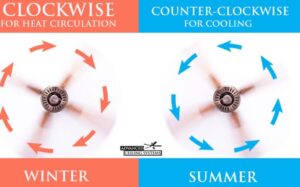A ceiling fan is a must-have appliance in your home during summer to ensure a cool environment. But you can also use your ceiling fan during winter making this crucial home appliance functional throughout the year.
Changing the direction of rotation of your ceiling fan during the hot and cold season not only guarantees ultimate comfort but also enables you to adjust your thermostat and give your heating unit the required break. Moreover, ceiling fans are energy-saving and at the same time environmentally friendly thus what you get is numerous benefits from installing this appliance.
This article will focus on some of the different ways in which your ceiling fan should turn.
If you are in a hurry, then let me tell you what way should a ceiling fan turn directly:

Reasons for Using Your Ceiling Fan During Summer
A ceiling fan is very important during summer for the following reasons:
– It reduces the need or use of central and also window air conditioning units.
-Your ceiling fan saves you up to 40% on the cost due to air conditioning.
– Cooling wind chill effect circulating on your skin keeps your room up to about eight degrees cooler.
– A ceiling fan allows you to spend enough time outdoors without having to sacrifice your comfort.
Reasons for Using Your Ceiling Fan During the Cold Season
Below are the reasons you will need a ceiling fan during winter:
– The appliance saves you up to 15% on the total heating costs.
– Your ceiling fan reduces electric hazards and clutter as a result of heating blankets and space heaters.
– A ceiling fan cuts the costs of heating fuel.
– Redistribution of warm air in your room makes it feel warm with maximum comfort to you and your family members.
What Way Should a Ceiling Fan Turn In the Summer?

During the hot season or rather during summer, your ceiling fan should rotate in a counterclockwise direction to force or push cool air down to your sitting environment and the floor.
The cool air then evaporates perspiration and, in turn, creates a wind-chill effect that makes you feel cooler and without altering with your room temperature. This enables you to set your thermostat at a higher temperature without diminishing your comfort.
How Do You Tell if Your Ceiling Fan is Ready for Summer?
Switch on your fan, then stand directly under your ceiling fan blades and then watch as the blades rotate. The fan blades should rotate from the top left and then down to the right, finally back to the top. To look for a more telltale sign, you should be able to feel the air movement as you stand under the fan. In the case where you do not feel the air movement, your fan is spinning in a clockwise direction.
The cooling comfort is one of the benefits that come with using a ceiling fan during summer. If you are a homeowner who uses a ceiling fan, then you will save a significant amount of up to 40% on the air conditioning bills. However, you should not confine yourself to the indoor comforts. If you can enjoy a sunny afternoon outside, you can buy an outdoor ceiling fan for your favorite outdoor spot patio or porch. Your outdoor ceiling fan will also keep insects and any other unwanted pests at bay.
Which Direction Should Ceiling Fan Go In Winter?

During winter or rather during the cold season, your ceiling fan should rate in a clockwise direction and at a low speed to pull cool air up.
The gentle updraft drives or pushes the warm air that naturally rises to your ceiling down along your walls and finally to the ground or floor. This makes your room feel warmer hence allowing you to lower your thermostat temperature and in turn, minimize the use of heating devices.
A homeowner who buys the idea of using a ceiling fan during the cold season saves approximately 15% on the total heating bills.
How Do You Tell That Your Ceiling Fan is Set for the Cold Season?
To tell that your ceiling fan is set for winter, turn on your ceiling fan and then stand directly below the ceiling fan blades and observe as the fan blades rotate. The fan blades should move just like a clock’s hand starting from the top and to the right and then down to the left, finally back to the top. All this should happen at a low speed to pull cool air up.
When to Break These Rules?
– Vaulted ceiling.
If your ceiling fan is mounted on a vaulted ceiling or a two-story cathedral, it is too high to create or develop a discernible wind chill. It can stay in a counterclockwise function throughout the year.
– The fan is over the table.
We carry out many tasks on the table including playing games, eating, or filing paperwork. In all these activities, you might not need a heavy breeze that is coming from the fan above and blowing your papers everywhere or your food. In these situations, the easiest way is to keep your ceiling fan rotating in a clockwise direction.
– You do not prefer air blowing on you while sleeping.
This is based on personal preferences. Some people prefer a cool breeze when sleeping while others do not. If the ceiling fan bothers you or keeps you awake, keep it in winter or rather in a clockwise direction.
– While watching your TV.
In bigger rooms such as your living room, likely, you will not be sitting directly under your ceiling fan. In such a case, set your ceiling fan to run in a clockwise direction to assist in circulating air in your entire room.
– To air out your room.
In the case where there is a foul smell or smoke in your room, set your fan to rotate in a clockwise direction, and maintain a medium speed. In this way, the fan will draw the smoke or bad smell up and then out towards the wall. You can also open the windows and the door for an extra push.
Conclusion
In conclusion, knowing what direction your ceiling fan should rotate during winter and summer is very important to help you save on cooling and heating without interfering with your family’s comfort. This article has informed you about the different ways that you can turn your fan to get the best out of it.
